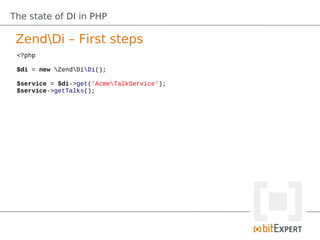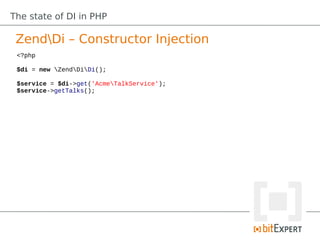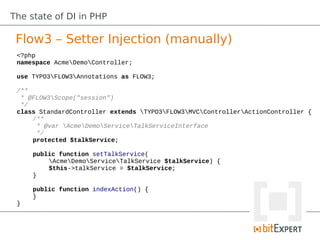The state of DI in PHP - phpbnl12
- 1. The state of DI in PHP
- 2. The state of DI in PHP About me Stephan Hochdörfer, bitExpert AG Department Manager Research Labs enjoying PHP since 1999 7 years of DI experience (in PHP) [email protected] @shochdoerfer
- 3. The state of DI in PHP What`s this talk about?
- 4. The state of DI in PHP What`s this talk about? No framework bashing! Hopefully :)
- 5. The state of DI in PHP What`s this talk about? It`s all about how DI is implemented.
- 6. The state of DI in PHP What`s DI about?
- 7. The state of DI in PHP Inversion of control
- 8. The state of DI in PHP „Hollywood principle“
- 9. The state of DI in PHP What`s DI about? new TalkService(new TalkRepository());
- 10. The state of DI in PHP What`s DI about? Consumer
- 11. The state of DI in PHP What`s DI about? Consumer Dependencies
- 12. The state of DI in PHP What`s DI about? Consumer Dependencies Container
- 13. The state of DI in PHP What`s DI about? Consumer Dependencies Container
- 14. The state of DI in PHP A little bit of history...
- 15. The state of DI in PHP 1988 „Designing Reusable Classes“ Ralph E. Johnson & Brian Foote
- 16. The state of DI in PHP 1996 „The Dependency Inversion Principle“ Robert C. Martin
- 17. The state of DI in PHP 2002
- 18. The state of DI in PHP 2003 Spring Framework 0.9 released
- 19. The state of DI in PHP 2004 „Inversion of Control Containers and the Dependency Injection pattern“ Martin Fowler
- 20. The state of DI in PHP 2004 Spring Framework 1.0 released
- 21. The state of DI in PHP 2004 PHP 5.0 released
- 22. The state of DI in PHP 2005 / 2006 Garden, a lightweight DI container for PHP.
- 23. The state of DI in PHP 2006 First PHP5 framework with DI support
- 24. The state of DI in PHP 2007 International PHP Conference 2007 features 2 talks about DI.
- 25. The state of DI in PHP 2009 PHP 5.3.0 released
- 26. The state of DI in PHP 2010 Fabien Potencier talks about „Dependency Injection in PHP 5.2 and 5.3“
- 27. The state of DI in PHP 2011 Symfony2, Flow3, Zend Framework 2 (beta)
- 28. The state of DI in PHP 2012 And now?
- 29. The state of DI in PHP DI has finally arrived in the PHP world!
- 30. The state of DI in PHP Let`s have a look at the different implementations!
- 31. The state of DI in PHP
- 32. The state of DI in PHP ZendDi – First steps <?php namespace Acme; class TalkService { public function __construct() { } public function getTalks() { } }
- 33. The state of DI in PHP ZendDi – First steps <?php $di = new ZendDiDi(); $service = $di->get('AcmeTalkService'); $service->getTalks();
- 34. The state of DI in PHP ZendDi – Constructor Injection <?php namespace Acme; interface GenericRepository { public function readTalks(); } class TalkRepository implements GenericRepository { public function readTalks() { } } class TalkService { public function __construct(TalkRepository $repo) { } public function getTalks() { } }
- 35. The state of DI in PHP ZendDi – Constructor Injection <?php $di = new ZendDiDi(); $service = $di->get('AcmeTalkService'); $service->getTalks();
- 36. The state of DI in PHP ZendDi – Setter Injection <?php namespace Acme; class Logger { public function doLog($logMsg) { } } class TalkService { public function __construct(TalkRepository $repo) { } public function setLogger(Logger $logger) { } public function getTalks() { } }
- 37. The state of DI in PHP ZendDi – Setter Injection <?php $di = new ZendDiDi(); $di->configure( new ZendDiConfiguration( array( 'definition' => array( 'class' => array( 'AcmeTalkService' => array( 'setLogger' => array('required' => true) ) ) ) ) ) ); $service = $di->get('AcmeTalkService'); var_dump($service);
- 38. The state of DI in PHP ZendDi – Interface Injection <?php namespace Acme; class Logger { public function doLog($logMsg) { } } interface LoggerAware { public function setLogger(Logger $logger); } class TalkService implements LoggerAware { public function __construct(TalkRepository $repo) { } public function setLogger(Logger $logger) { } public function getTalks() { } }
- 39. The state of DI in PHP ZendDi – Interface Injection <?php $di = new ZendDiDi(); $service = $di->get('AcmeTalkService'); $service->getTalks();
- 40. The state of DI in PHP ZendDi – General usage <?php $di = new ZendDiDi(); $service = $di->get('AcmeTalkService'); var_dump($service); $service2 = $di->get('AcmeTalkService'); var_dump($service2); // same instance as $service $service3 = $di->get( 'AcmeTalkService', array( 'repo' => new phpbnl12TalkRepository() ) ); var_dump($service3); // new instance
- 41. The state of DI in PHP ZendDi – Builder Definition <?php // describe dependency $dep = new ZendDiDefinitionBuilderPhpClass(); $dep->setName('AcmeTalkRepository'); // describe class $class = new ZendDiDefinitionBuilderPhpClass(); $class->setName('AcmeTalkService'); // add injection method $im = new ZendDiDefinitionBuilderInjectionMethod(); $im->setName('__construct'); $im->addParameter('repo', 'AcmeTalkRepository'); $class->addInjectionMethod($im); // configure builder $builder = new ZendDiDefinitionBuilderDefinition(); $builder->addClass($dep); $builder->addClass($class);
- 42. The state of DI in PHP ZendDi – Builder Definition <?php // add to Di $defList = new ZendDiDefinitionList($builder); $di = new ZendDiDi($defList); $service = $di->get('AcmeTalkService'); var_dump($service);
- 43. The state of DI in PHP
- 44. The state of DI in PHP Symfony2 <?php namespace AcmeTalkBundleController; use SymfonyBundleFrameworkBundleControllerController; use SensioBundleFrameworkExtraBundleConfigurationRoute; use SensioBundleFrameworkExtraBundleConfigurationTemplate; class TalkController extends Controller { /** * @Route("/", name="_talk") * @Template() */ public function indexAction() { $service = $this->get('acme.talk.service'); return array(); } }
- 45. The state of DI in PHP Symfony2 – Configuration file File services.xml in src/Acme/DemoBundle/Resources/config <?xml version="1.0" ?> <container xmlns="http://symfony.com/schema/dic/services" xmlns:xsi="http://www.w3.org/2001/XMLSchema-instance" xsi:schemaLocation="http://symfony.com/schema/dic/services http://symfony.com/schema/dic/services/services-1.0.xsd"> </container>
- 46. The state of DI in PHP Symfony2 – Constructor Injection <?xml version="1.0" ?> <container xmlns="http://symfony.com/schema/dic/services" xmlns:xsi="http://www.w3.org/2001/XMLSchema-instance" xsi:schemaLocation="http://symfony.com/schema/dic/services http://symfony.com/schema/dic/services/services-1.0.xsd"> <services> <service id="acme.talk.repo" class="AcmeTalkBundleServiceTalkRepository" /> <service id="acme.talk.service" class="AcmeTalkBundleServiceTalkService"> <argument type="service" id="acme.talk.repo" /> </service> </services> </container>
- 47. The state of DI in PHP Symfony2 – Setter Injection <?xml version="1.0" ?> <container xmlns="http://symfony.com/schema/dic/services" xmlns:xsi="http://www.w3.org/2001/XMLSchema-instance" xsi:schemaLocation="http://symfony.com/schema/dic/services http://symfony.com/schema/dic/services/services-1.0.xsd"> <services> <service id="acme.talk.logger" class="AcmeTalkBundleServiceLogger" /> <service id="acme.talk.repo" class="AcmeTalkBundleServiceTalkRepository" /> <service id="acme.talk.service" class="AcmeTalkBundleServiceTalkService"> <argument type="service" id="acme.talk.repo" /> <call method="setLogger"> <argument type="service" id="acme.talk.logger" /> </call> </service> </services> </container>
- 48. The state of DI in PHP Symfony2 – Setter Injection (optional) <?xml version="1.0" ?> <container xmlns="http://symfony.com/schema/dic/services" xmlns:xsi="http://www.w3.org/2001/XMLSchema-instance" xsi:schemaLocation="http://symfony.com/schema/dic/services http://symfony.com/schema/dic/services/services-1.0.xsd"> <services> <service id="acme.talk.logger" class="AcmeTalkBundleServiceLogger" /> <service id="acme.talk.repo" class="AcmeTalkBundleServiceTalkRepository" /> <service id="acme.talk.service" class="AcmeTalkBundleServiceTalkService"> <argument type="service" id="acme.talk.repo" /> <call method="setLogger"> <argument type="service" id="acme.talk.logger" on-invalid="ignore" /> </call> </service> </services> </container>
- 49. The state of DI in PHP Symfony2 – Property Injection <?xml version="1.0" ?> <container xmlns="http://symfony.com/schema/dic/services" xmlns:xsi="http://www.w3.org/2001/XMLSchema-instance" xsi:schemaLocation="http://symfony.com/schema/dic/services http://symfony.com/schema/dic/services/services-1.0.xsd"> <services> <service id="acme.talk.repo" class="AcmeTalkBundleServiceTalkRepository" /> <service id="acme.talk.service" class="AcmeTalkBundleServiceTalkService"> <property name="talkRepository" type="service" id="acme.talk.repo" /> </service> </services> </container>
- 50. The state of DI in PHP Symfony2 – private/public Services <?xml version="1.0" ?> <container xmlns="http://symfony.com/schema/dic/services" xmlns:xsi="http://www.w3.org/2001/XMLSchema-instance" xsi:schemaLocation="http://symfony.com/schema/dic/services http://symfony.com/schema/dic/services/services-1.0.xsd"> <services> <service id="acme.talk.logger" class="AcmeTalkBundleServiceLogger" public="false" /> <service id="acme.talk.repo" class="AcmeTalkBundleServiceTalkRepository" /> <service id="acme.talk.service" class="AcmeTalkBundleServiceTalkService"> <argument type="service" id="acme.talk.repo" /> <call method="setLogger"> <argument type="service" id="acme.talk.logger" /> </call> </service> </services> </container>
- 51. The state of DI in PHP Symfony2 – Service inheritance <?xml version="1.0" ?> <container xmlns="http://symfony.com/schema/dic/services" xmlns:xsi="http://www.w3.org/2001/XMLSchema-instance" xsi:schemaLocation="http://symfony.com/schema/dic/services http://symfony.com/schema/dic/services/services-1.0.xsd"> <services> <service id="acme.talk.serviceparent" class="AcmeTalkBundleServiceTalkService" abstract="true"> <property name="talkRepository" type="service" id="acme.talk.repo" /> </service> <service id="acme.talk.service" parent="acme.talk.serviceparent" /> <service id="acme.talk.service2" parent="acme.talk.serviceparent" /> </services> </container>
- 52. The state of DI in PHP Symfony2 – Service scoping <?xml version="1.0" ?> <container xmlns="http://symfony.com/schema/dic/services" xmlns:xsi="http://www.w3.org/2001/XMLSchema-instance" xsi:schemaLocation="http://symfony.com/schema/dic/services http://symfony.com/schema/dic/services/services-1.0.xsd"> <services> <service id="acme.talk.repo" class="AcmeTalkBundleServiceTalkRepository" /> <service id="acme.talk.service" class="AcmeTalkBundleServiceTalkService" scope="prototype"> <property name="talkRepository" type="service" id="acme.talk.repo" /> </service> </services> </container>
- 53. The state of DI in PHP
- 54. The state of DI in PHP Flow3 – Constructor Injection <?php namespace AcmeDemoController; use TYPO3FLOW3Annotations as FLOW3; /** * @FLOW3Scope("session") */ class StandardController extends TYPO3FLOW3MVCControllerActionController { /** * @var AcmeDemoServiceTalkServiceInterface */ protected $talkService; public function __construct( AcmeDemoServiceTalkService $talkService) { $this->talkService = $talkService; } public function indexAction() { } }
- 55. The state of DI in PHP Flow3 – Constructor Injection (manually) <?php namespace AcmeDemoController; use TYPO3FLOW3Annotations as FLOW3; /** * @FLOW3Scope("session") */ class StandardController extends TYPO3FLOW3MVCControllerActionController { /** * @var AcmeDemoServiceTalkServiceInterface */ protected $talkService; public function __construct( AcmeDemoServiceTalkService $talkService) { $this->talkService = $talkService; } public function indexAction() { } }
- 56. The state of DI in PHP Flow3 – Setter Injection (manually) <?php namespace AcmeDemoController; use TYPO3FLOW3Annotations as FLOW3; /** * @FLOW3Scope("session") */ class StandardController extends TYPO3FLOW3MVCControllerActionController { /** * @var AcmeDemoServiceTalkServiceInterface */ protected $talkService; public function setTalkService( AcmeDemoServiceTalkService $talkService) { $this->talkService = $talkService; } public function indexAction() { } }
- 57. The state of DI in PHP Flow3 – Setter Injection (manually) File Objects.yaml in Packages/Application/Acme.Demo/Configuration # @package Acme AcmeDemoControllerStandardController: properties: talkService: object: AcmeDemoServiceTalkService
- 58. The state of DI in PHP Flow3 – Setter Injection (Automagic) <?php namespace AcmeDemoController; use TYPO3FLOW3Annotations as FLOW3; /** * @FLOW3Scope("session") */ class StandardController extends TYPO3FLOW3MVCControllerActionController { /** * @var AcmeDemoServiceTalkServiceInterface */ protected $talkService; public function injectTalkService( AcmeDemoServiceTalkService $talkService) { $this->talkService = $talkService; } public function indexAction() { } }
- 59. The state of DI in PHP Flow3 – Setter Injection (Automagic) <?php namespace AcmeDemoController; use TYPO3FLOW3Annotations as FLOW3; /** * @FLOW3Scope("session") */ class StandardController extends TYPO3FLOW3MVCControllerActionController { /** * @var AcmeDemoServiceTalkServiceInterface */ protected $talkService; public function injectSomethingElse( AcmeDemoServiceTalkService $talkService) { $this->talkService = $talkService; } public function indexAction() { } }
- 60. The state of DI in PHP Flow3 – Property Injection <?php namespace AcmeDemoController; use TYPO3FLOW3Annotations as FLOW3; /** * @FLOW3Scope("session") */ class StandardController extends TYPO3FLOW3MVCControllerActionController { /** * @var AcmeDemoServiceTalkService * @FLOW3Inject */ protected $talkService; public function indexAction() { } }
- 61. The state of DI in PHP Flow3 – Property Injection (with Interface) <?php namespace AcmeDemoController; use TYPO3FLOW3Annotations as FLOW3; /** * @FLOW3Scope("session") */ class StandardController extends TYPO3FLOW3MVCControllerActionController { /** * @var AcmeDemoServiceTalkServiceInterface * @FLOW3Inject */ protected $talkService; public function indexAction() { } }
- 62. The state of DI in PHP Flow3 – Property Injection (with Interface) File Objects.yaml in Packages/Application/Acme.Demo/Configuration # @package Acme AcmeDemoServiceTalkServiceInterface: className: 'AcmeDemoServiceTalkService'
- 63. The state of DI in PHP Flow3 – Scoping <?php namespace AcmeDemoController; use TYPO3FLOW3Annotations as FLOW3; /** * @FLOW3Scope("session") */ class StandardController extends TYPO3FLOW3MVCControllerActionController { /** * @var AcmeDemoServiceTalkServiceInterface * @FLOW3Inject */ protected $talkService; public function indexAction() { } }
- 64. The state of DI in PHP The future?
- 65. The state of DI in PHP The future (or what`s missing)?
- 66. The state of DI in PHP PSR for DI container missing!
- 67. The state of DI in PHP IDE support is missing...
- 68. Thank you!













































































































































![Iobit Driver Booster Pro Crack Free Download [Latest] 2025](https://cdn.slidesharecdn.com/ss_thumbnails/informationtechnology5-250522164349-8a98d122-thumbnail.jpg?width=560&fit=bounds)














